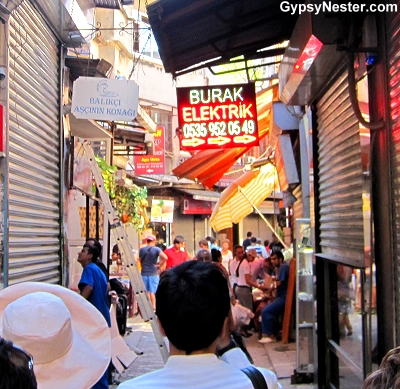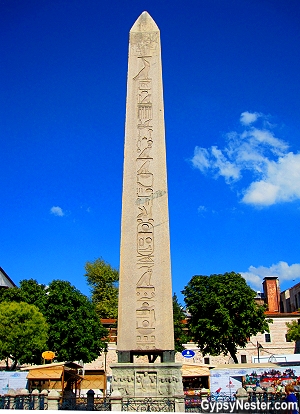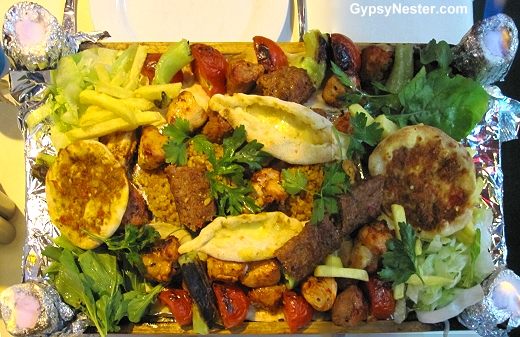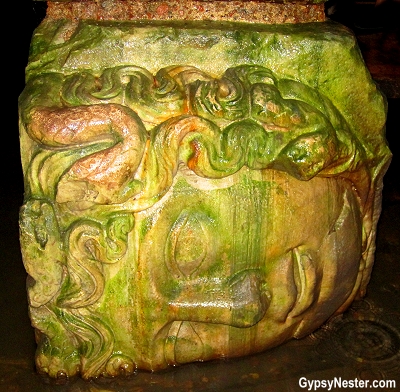Thanks to Princess Cruises for inviting us along and providing this adventure! As always, all opinions are our own. See our entire Mediterranean voyage aboard the Royal Princess here

Rome may be The Eternal City, but Istanbul can make a pretty good case for immortality too. It is certainly not some insignificant transient stop along the highway of history.
The cities are about the same age, both over two and a half millennia, and for much of that time the larger, wealthier, and more influential of the two was not the one in Italy. In fact Istanbul, known as Constantinople at the time, spent hundreds of years ruling over Rome as the capital of the Roman Empire.

By the time we arrived, early in the twenty-first century, Byzantium/ Constantinople/ Istanbul was no longer the capital of anything, not even Turkey, but it remains one of the world’s great cities.
In an effort to soak up some of that history we chose to stay right inside the ancient walls, in the heart of the Old City. Most all of the major landmarks were within an easy walk of our hotel.

Jetlagged and hungry, we set out to see what we could find, since it was too early to check in.
First thing that caught our eyes was a woman sitting in the front window of a restaurant called The Han making what looked to be tortillas.
She rolled the dough out on a big wooden table, laid fillings on top, then folded it over and cooked it on a griddle. It looked great, so we had to go in.

We sat on pillows and ordered two of the gözleme, one with meat filling and another with spinach and cheese. Delicious!
The name comes from the Turkish göz, which means compartment. While eating, we noticed that nearly everyone who passed by on the sidewalk stopped to watch the lady making gözleme. Seems The Han had discovered the best advertising possible.
We perked up a bit after eating and walked to Sultanahmet Square, the heart of the Old City. The square is flanked by The Blue Mosque and Hagia Sophia, two of Istanbul’s most famous landmarks.
In fact most of the city’s main attractions are within a stone’s throw, The Topkapı Palace, Basilica Cistern, Grand Bazaar, and Hippodrome are all nearby. We couldn’t possibly visit all of these in one afternoon, but we could start at the top.
A Stop in Sultanahmet Square – The Blue Mosque
The square is named for the Sultanahmet Mosque, the official name of The Blue Mosque, so that would be first on our list. Built in 1609 by Sultan Ahmed I, it features a main dome, eight secondary domes, and six minarets, and is considered the pinnacle of two centuries of Ottoman mosque development.
Upon entering the mosque we saw how the unofficial blue moniker came about, the color is prevalent in the tiles adorn that the interior.
This is still an active mosque, so as the time for prayers approached, visitors were ushered out. Back in the square, we were just in time for the call to prayer, and learned what the minarets are for.
Originally a Muezzin would climb to a balcony on each minaret and call out the adhan five times a day, but now each minaret has several loud speakers.
With half a dozen mosques within earshot of the square, the mid-afternoon call became quite an audio spectacular. In our time-zone-addled condition it struck us as almost surreal.
WATCH: It’s impossible to show the enormity of the mosque in photos – video helps!
Click here for more photos and information about visiting The Blue Mosque

In keeping with our jet lag suppression theory, that a nap and then staying up as late as we can manage on our first night helps to acclimate, we checked in and crashed for a bit.
After waking in one of those “Is it morning or late afternoon?” freak-outs, we got ourselves together and set out. We certainly weren’t going to waste any time.
Haggling in the Grand Bazaar

We wandered through some back streets toward The Grand Bazaar, got a little lost, and then pointed back in the the right direction by some neighborhood kids.
They were extremely friendly and seemed to find our cluelessness quite amusing.
Finally finding our way to the granddaddy of all malls we ventured in to one of the oldest and certainly largest covered markets in the world.
It seemed as though most of the 400,000 visitors who come each day were inside with us.
Talk about lost, with over three thousand shops packed in along sixty-one covered streets, we felt like lab rats looking for cheese (when we did stumble upon one of cheese shops, it didn’t help much).
Click here for more Grand Bazaar
WATCH: A romp through the Grand Bazaar – Veronica learns to haggle!
After adjusting to the spectacle of product overload, we focused on the architecture. When the market was built, in 1455, Istanbul was very much the crossroad between Europe and Asia, and the bazaar soon became the hub of trade between the continents, so it had to be spectacular.
Merchants came from far and wide to stock up on items to sell back home.
But over the course of four and a half centuries things had changed, fires and earthquakes nearly dealt a death blow to the already declining bazaar.
After fading and falling into in disrepair until the 1950s it staged a comeback.
By the 1980s restorations had taken place and the bazaar returned to its glory. These days tourists, rather than merchants, come from far and wide, and the name grand is fitting once again.
Click here for more Grand Bazaar
WATCH: See how Turkish carpets are made, what kinds of dyes are used and how to spot quality – and see a REAL flying carpet!
Istanbul At Night

We came out of the maze into narrow neighborhood back streets again. But things were very different, it was nearing sundown, and during Ramadan, so the city looked like a ghost town.
All the shops had closed and everyone was home getting ready to eat for the first time since sunrise.

Once the sun set, life picked up again especially around Sultanahmet Square.
The scene was almost like a fair, the fountain glowed with colorful lights, vendors were selling food and trinkets, and families spread out picnics on the grass. As soon as it was completely dark another adhan rang out from the mosques and a huge group assembled in the square for prayers under the stars.
WATCH: A sweet street food – osmanli macunu – it’s dessert AND a show!

Walking back to the hotel we passed The Column of Constantine, constructed on the orders of the Roman emperor Constantine the Great in 330 AD. This marked the city’s change from the Greek Byzantium, to the Roman Nova Roma.
The New Rome became the capital city of the Roman Empire, and in time took on the name of its ruler, to be known as Constantinople.

Across from the column we picked up a variety of Turkish Delight in a little shop, not only to try the many flavors, but to celebrate our accomplishment of staying up late enough to reset our body clocks. Time for a little Istanbul-dozing.
A Wonderful Clash of Culture – Hagia Sophia
Bright and early we headed for Hagia Sophia, which could be one of the most impressive structures we’ve ever seen.
Not so much for the building itself, although it is spectacular, but for the fact that this massive cathedral was built in the year 532, and finished in only five years.
The Emperor Justinian wanted to build the largest church in the world, and succeeded… by a long shot. It remained unchallenged for almost one thousand years, until the Renaissance cathedrals of Europe finally caught up. But those all took decades, if not centuries, to construct.
Like many of the churches in Istanbul, it served first as a cathedral, then as a mosque. Now it is a museum commemorating both of those pasts. Interestingly, unlike many other churches, when Hagia Sophia was converted to a mosque the Christian artwork was not destroyed, only covered over.
As restorations took place, several masterpieces were found intact. Now it is one of the few places where Christian and Muslim art are displayed side by side.
Follow us into the Hagia Sophia…
The Sultans Certainly Picked a Lovely Spot
The Topkapı Palace stands just behind the former cathedral and is where, after the fall of the Roman Empire to the Ottoman Empire in 1453, the sultans and their courts lived for four hundred years.
Once conquered, the city’s name was changed once again, and Turkey was ruled from Istanbul.
See more photos and info about Topkapı Palace
When the Ottoman Empire ended after World War I and Turkey became a republic, the capital was moved to Ankara and the palace became a museum of the imperial era. We were rightly amazed by some of the items on display.
The sultans had quite a collection of jaw dropping jewels, among them a gold box filled of emeralds, multiple ruby and diamond handled swords and daggers, and the highlight, the Spoonmaker’s Diamond, one of the largest in the world at eighty-six carats.
Across the courtyard there are perhaps even more valuable treasures, a plethora of holy relics from Islam, Judaism, and Christianity. Among them, the oldest known copy of The Koran, several bits of Muhammad’s beard, a cloak and a sword also said to belong to the prophet, a staff that Moses carried, and bones of John The Baptist. We cannot show these since no photos were allowed, so some things must be taken on faith.
Very apropos where relics are concerned, and while we are prone to take the authenticity of most with a grain of salt, a little research showed that at least some, particularly the ones attributed to Muhammad, may be genuine.
See more photos and info about Topkapı Palace
Underworld Charm
Several hundred ancient cisterns lie beneath the city, but The Basilica Cistern is the largest, and the only one we knew how to get inside. Descending into the damp darkness felt pretty darn good on a hot August Mediterranean day and, once our eyes adjusted, we were dumbfounded by the sight.
Row after row of hundreds of columns hold up arches and domes in a stunning work of architecture that was never meant to be seen.
The huge space was built as a water storage facility which was used by the city for around fifteen hundred years. Those zany Romans hid all of this surprisingly ornate work under twenty-one million gallons of water.
For unknown reasons, they also chose to hide oddly-angled sculpted heads of Medusa at the base of two pillars in one of the corners.
Descend into the Basilica Cistern with us to see the upside-down Medusa and other oddities
Off to the (Chariot) Races!

Back up in the sunlight we had one last stop, The Hippodrome. The track and stands are long gone, but with a little imagination we could still see the crowds and hear the thundering chariots.
It was originally built by the Greeks, but Constantine knew that a great Roman city needed a great race track.
So the new Emperor expanded the arena to hold 100,000 spectators.
Then he did a little decorating, which we didn’t have to visualize because the monuments survived. He installed an ancient Greek column formed from three intertwined bronze serpents that was taken from the Temple of Apollo at Delphi.
Later, Theodosius erected an obelisk from Egypt that had already been around nearly two thousand years when he put it up in 390 AD. Now over thirty five hundred years old, this was probably the oldest man made object we’ve ever seen.

With another Ramadan sunset fast approaching, we set out in search of supper. Avoiding the tourist traps, we took a side street and ended up at Antakya, which looked to be serving a mix of natives and travelers alike.
A fresh breeze off The Sea of Marmara had cooled the evening, so we took a sidewalk table and ordered a couple Efes, the local brew.
Luckily the menu had pictures, but when we started pointing at things the waiter had a better idea, bring on the Sultan’s Delight, or Feast, or whatever, for two.
A platter only slightly smaller than our table arrived, piled high with various grilled meats, veggies and breads, on a bed of rice. For a bit of flair, columns of flame adorned each corner. Dangerous, but delictable.

Eating so close to fire was more than enough to remind us of our sleep deprived condition and put us down for the count. It also was most certainly fit for a sultan.
And that’s no Istanbul.
Getting Around
WATCH: Of course David the Train Nut needed to ride something on rails and, lucky for him, there is a funicular that goes up the steep hillside from the waterfront to Taksim Square. Because it runs inside the mountain, it’s the only funicular we’ve ever been on that didn’t scare the tar out of Veronica!

Istanbul’s Old City can be a bit overwhelming but there is always help. Flag down a young person wearing an “ask me” shirt.
This is a fantastic college volunteer program
that we utilized quite a bit. These young folks are knowledgable, friendly, and speak so many languages, we’d be surprised if it were possible to stump them!
David & Veronica, GypsyNester.com
Delve Deeper:
The Blue Mosque
Grand Bazaar
Hagia Sophia
Basilica Cistern
The Topkapı Palace
Thanks to Princess Cruises for inviting us along and providing this adventure! As always, all opinions are our own. See our entire Mediterranean voyage aboard the Royal Princess here


















Your website has superb web content. I bookmarked the
site
Your web site has outstanding content. I bookmarked the website
Great post! Have nice day ! 🙂 dtp99
Just come back from a holday in Turkey.It was a fantastic trip Wonderful one day fantastic the next day.Istanbul is a great city plenty of atmosphere. June
It is a great city!
Great photos, you made me want to go back now!!
Thanks Natalie.
Absolutely stunning! Thank you for sharing these gorgeous photos! I would love to see more of this city when time allows and it was delightful to experience it through your eyes!
Thank you Mary!
Absolutely beautiful! This has always been on my list, and these great pics just reinforce that!
Having seen it, we would say it should be on everyone’s list. Thanks.
All my friends say it’s wonderful I have to go someday and explore it for myself. Great photos! I love them.
Your friends are right! Thanks.
I am in awe of how much you covered in a single post and absolutely loved the video detailing the carpet production method! Gorgeous work! Istanbul is breathtaking and I would love to be there with you, wandering the streets and listening to the call to prayers echoing throughout the city!
Thanks, it really was great.
You’ve convinced me that we most definitely need to add Istanbul to our “must visit” cities. Interesting to see an Islamic country that allows displays of other religions’ iconography.
We did have a fantastic time. Food was great and so much history. Not huge fans of the coffee though.
Looks like you had a fantastic time! LOVE the gozleme. Also, nothing beats a true Turkish breakfast – accompanied with some Turkish coffee of course. 🙂